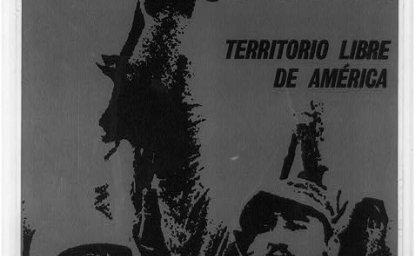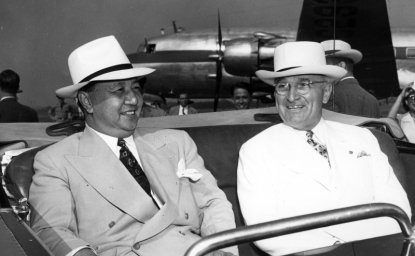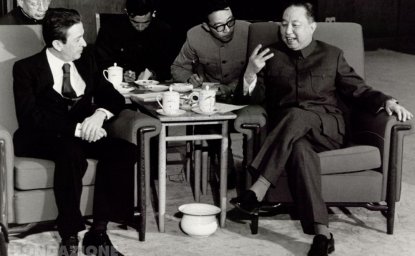Les Crystal was the London bureau chief for NBC News the day I stopped by his office in the fall of 1971. At the age of 37, he was smiling, positive, and wonderfully curious, just the person I had hoped to find. Since he had worked in local news in the Midwest before joining NBC, he was receptive to ideas coming from local news reporters.
When I told him I was on my way to East Africa for six weeks of story gathering for my small NBC station in Northern California, he immediately encouraged me to send him some of my reports
If a story was worthy, he said, he would pass it along to the Nightly News in New York.
A month later, it happened.
In Tanzania, I interviewed President Julius Nyerere. My cameraman and I filmed a Chinese-style People’s Militia parading in the country’s Independence Day celebration. We found Chinese Army officers walking the aisles as Nyerere showed four visiting African heads of state a railroad line to Zambia. The line was under construction by 14,000 Chinese workers.
An American diplomat told me he was worried the Chinese were secretly taking over the country.
Nyerere scoffed and smiled. “Remember,” he told me, “That’s 14 thousand, not 14 million.”
The most important fact appeared as two lines in my script: “What the [rail] line promises for Tanzania is an opening of transport for hundreds of settlements and villages across two countries. For the Chinese, it promises strong African support in international affairs for having built a railroad the United States refused to finance.”
The TanZam Railroad was the first of many industrial foreign aid projects launched in Africa by Communist China as it competed with both the Soviet Union and the United States in the developing world. Because of Crystal’s foresight, NBC News told the story first. The footage from this report is now available at the San Diego State University Network Television News Archive.
***
At top (pre-Internet) speed, I shipped my story (script, sound track and 16-millimeter film) by overnight flight from Dar-es-Salaam to London. Crystal scanned and shipped the materials by overnight flight to New York. The story appeared on the NBC News weekend broadcast.
The script ran less than two minutes (1:57) and contained only the barest details. This is still the custom of 30-minute commercial newscasts (roughly 22 minutes of news and 8 minutes of commercials).
“I’m hoping that someday someone will come up with a formula that will allow us to have an hour of network news,” Crystal told TV Guide magazine several years later when he became executive producer of the NBC Nightly News.
Crystal got his wish but it came in a melancholy fashion. After becoming executive producer, then promoted to news division president, Crystal was removed in a company-wide dispute between its owners and the news division’s top executives.
Moving to PBS, he inherited a half hour program described as “leisurely paced.” That’s when he seized the opportunity to make a major change.
Crystal and the two anchors (Robert MacNeil and Jim Lehrer) quickly refashioned the program to run an hour.
They formatted the time to include at least three major reports each night based on the day’s most important events. They added regular segments on the sciences, literature, and the arts, subjects long ignored for lack of time by the three commercial network newscasts. Crystal also doubled the staff and made it more diverse.
Searching for a vast increase in funding, the three journalists pegged the changes as a public service.
“If we were going to ask the public for money,” MacNeil told The Washington Post, “we had to be better than commercial television, or different from it. We needed to think afresh about how to do it and who could lead it.”
The result — 27 years later — is a landscape in which each night, nearly 3 million viewers (2.8 million) watch the PBS NewsHour. Commercial newscasts still draw many more viewers: ABC (10.9 million), NBC (9.9 million). CBS (6.0 million) in recent ratings.
Nevertheless, the commercial network newscasts are sometimes scattered and jumbled by a hopscotch attention to time restraints.
One recent example: After a commercial break on its July 8 evening newscast, the ABC News anchor appeared for 3 seconds, narrated a swirling weather map for 6 seconds, forecasting a “possible storm front” moving up the East Coast the following day, then announced there would be more news after more commercials. Total news segment time: 12 seconds.
To be fair, stories on the three commercial newscasts are sometimes brilliantly compressed and remarkably informative.
But PBS NewsHour stories are often far more focused and filled with much greater perspective, a mark of Crystal’s handiwork. He told the Christian Science Monitor in 1984: “Within the time constraints of network news, they can give the public what’s happened but very little of the hows and whys — and they are most important. NewsHour always manages to find time for the hows and the whys. Network news must do more of that sooner or later.”
***
When Crystal passed away in June, the world of journalism rose to bid him fond farewell with special praise.
The New York Times said Crystal had made the PBS NewsHour “a distinctive voice in broadcast journalism.” The Washington Post said he led a transition “to a full one-hour newscast…that was a first for American television.”
Paul Solman, a reporter who worked under Crystal at PBS, praised his tenacity: “He was infuriatingly scrupulous, poring over scripts like a Medieval scribe. Even-handedness was an article of faith, never to let It go.”
Judy Woodruff, the longtime NBC News White House correspondent and currently the NewsHour anchor, said “Few people have had as much of an influence on the NewsHour as Les Crystal…Always behind the camera, Les led the way to transforming this program.”
Nearly half a century after his alertness led to a clearer public awareness of Beijing’s emerging foreign policy, meeting Les Crystal that day in London in 1971 remains one off my most cherished memories as a journalist.






